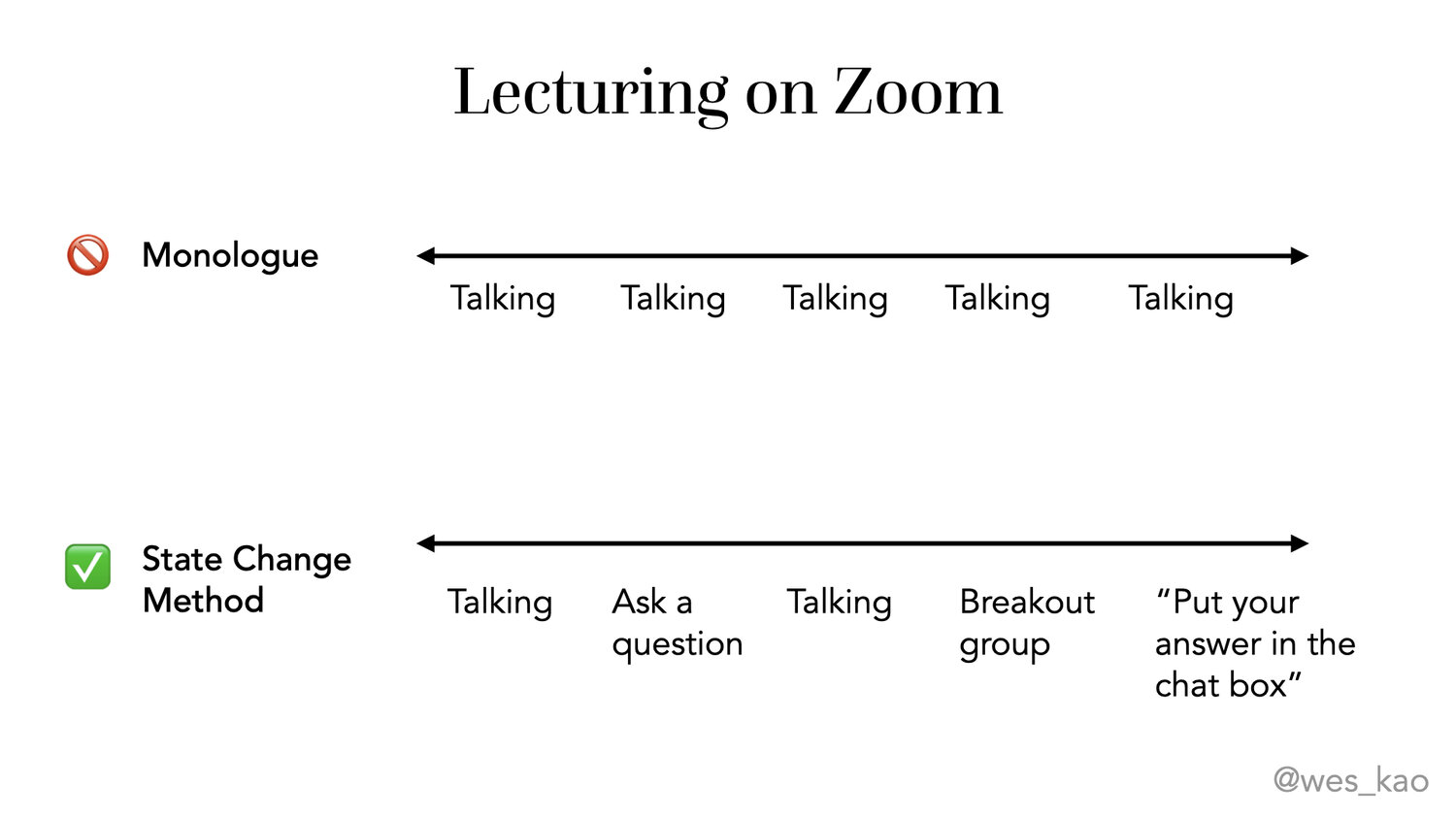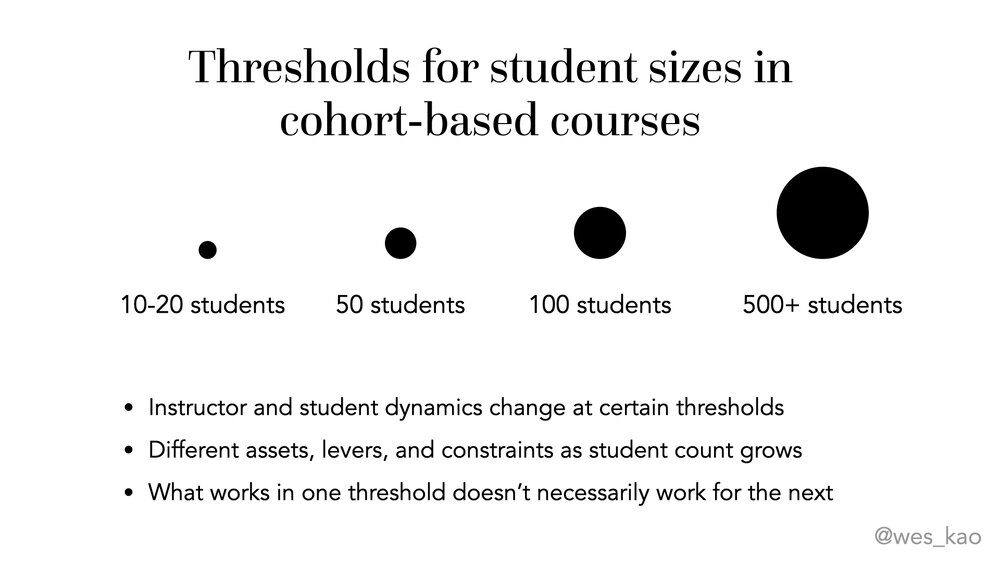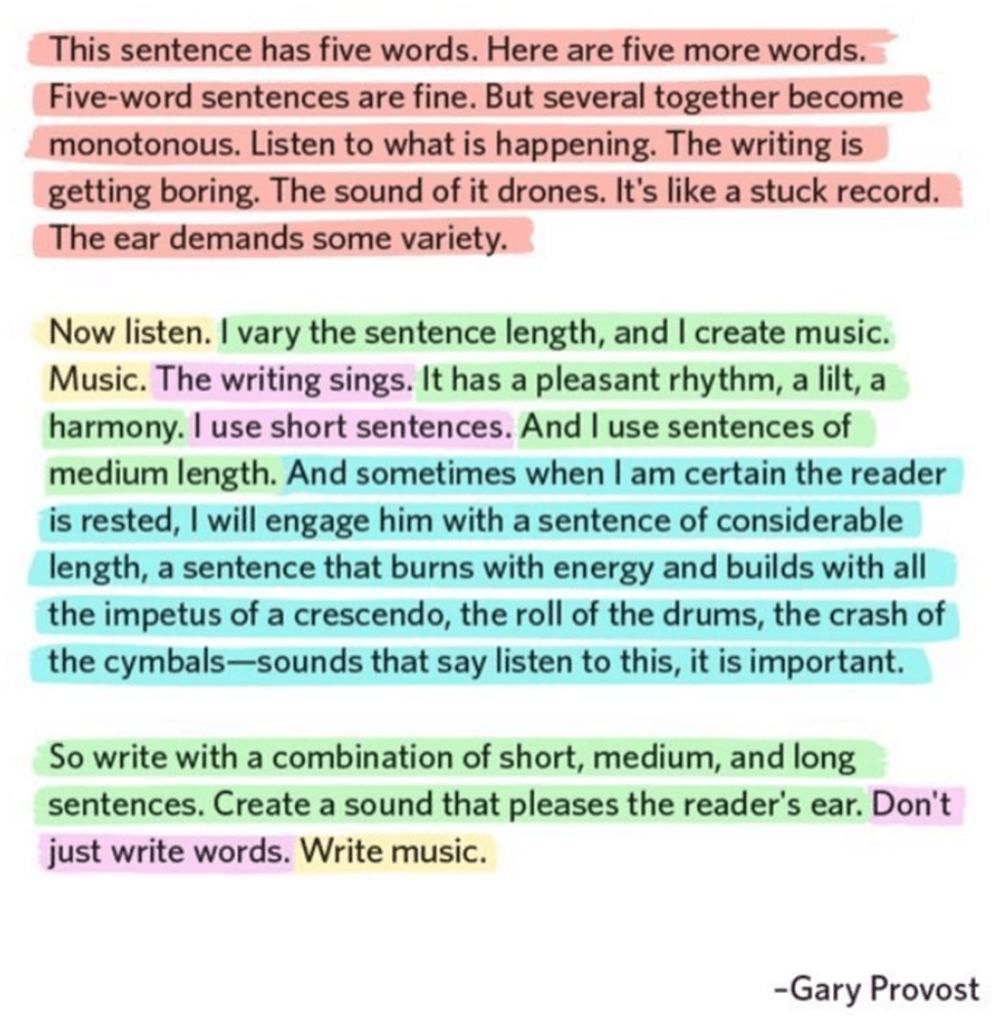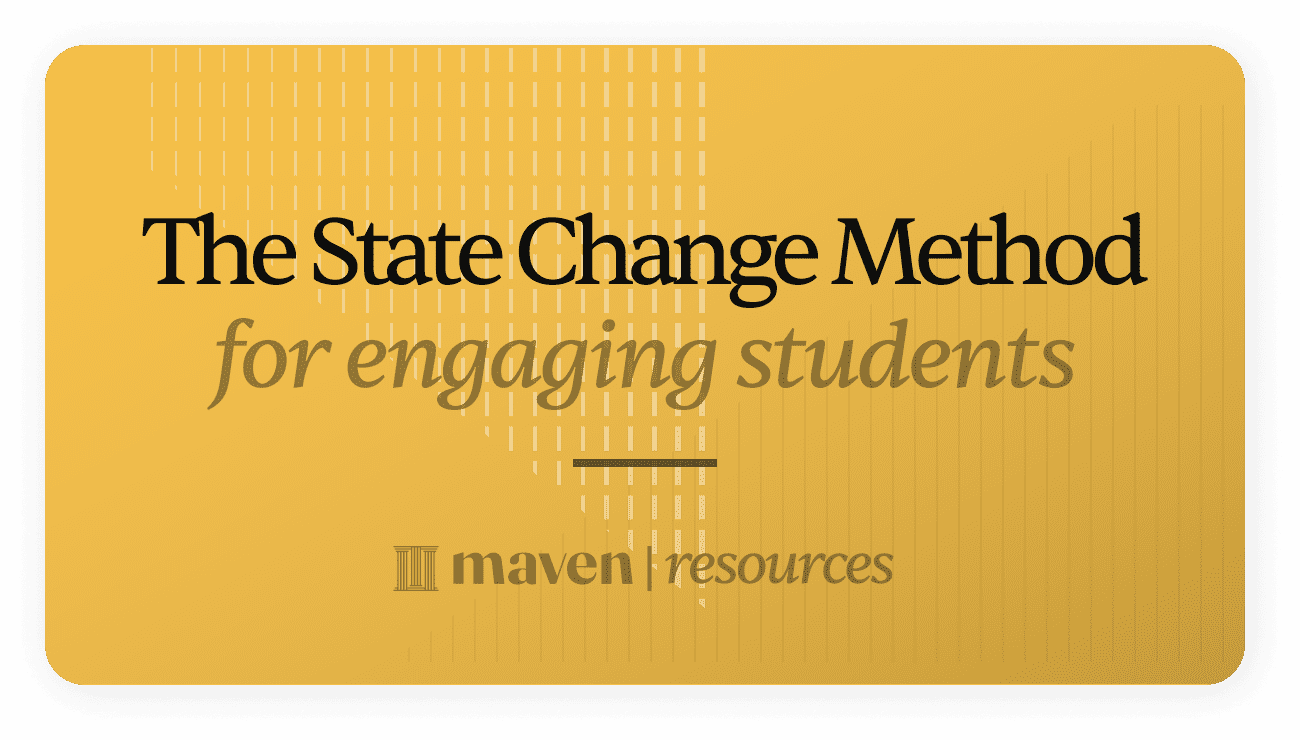Students don't owe you their attention. Once you internalize this, you can embrace the fact that it's your responsibility to keep your audience engaged.
Listening to one person talk for long stretches of time is mind-numbing--especially on Zoom where you have to sit still, stare ahead, and maintain eye contact with a screen. If you’re teaching online, whether informally or formally, it's important to make sure your audience is awake and paying attention.

Luckily, the State Change Method is an approach you can use across subject matter regardless of what you’re teaching, and it’s simple enough to start practicing today.
Monotony causes audiences to tune out. Movement causes audiences to become alert.
Humans are alert to change. Shiny pieces of foil catch our eyes because there are evolutionary benefits to looking out for movement and change. If I’m hunting in the savanna, I don’t need to watch out for rocks and trees. I do need to watch for a rabbit running so I can hunt it for food. Or watch for rustling grass where it’s either prey to hunt, or a predator coming to hunt me. Scanning for change is what humans naturally do.
This is why it’s so excruciating to sit still listening to one person lecture for an hour straight without your mind wandering. It’s hard to stay focused long enough to actually learn.
State Change Method
Aim for a state change every 3–5 minutes to break up the monotony of a monologue-style lecture. A state change is anything that punctuates an instructor’s monologue and offers a change in pace that causes students to perk up and snap back to attention.
State changes include:
breakout rooms
asking students to comment in the chat box
switching from screen share back to gallery view mode, vice versa
asking students to unmute to chime in
literally having anyone else talk
putting a question on the screen to ask students to reflect silently
cracking a joke and adding humor
giving the mic to other students to share
asking students to pause to internalize what was said
Q&A
group discussions
The State Change Method is built around modern audiences that are even more naturally restless—and instead of blaming people for not being able to sit still, the responsibility is on the instructor (that’s you) to make the lectures exciting enough to want to stay awake for.
You are 50% instructor, 50% entertainer
Your goal as an instructor is to create student transformation. In order to do that, you need to be equal parts instructor and entertainer.
If you’re 90% instructor and 10% entertainer, you’re a college professor. Professors are the only content creators who have a guaranteed captive audience. Students HAVE TO stay in their seats--even if the material is boring, irrelevant, not engaging. The bar is low. Professors who are a tiny bit more engaging are considered superstars.
Now that universities have to compete with everyone else, they have to compete with cohort-based courses and content creators who actually had to earn a student's attention. Luckily students everywhere will benefit from this culling--it forces everyone to level up and gives students the experience they deserved all along.
If you’re 10% instructor and 90% entertainer, you’re a human incarnation of a BuzzFeed video. There are lots of sources of entertainment or edutainment. At the end of the day, your students need to feel like the price they paid was worth the money and they left better than when they arrived.
A conversation versus a performance
You don’t “lecture” to a group of 5 people. You have a conversation with them.
When you’re in a small group, the dynamics are different because the tone is conversational. It’s a small enough group where you can see everyone’s face on gallery view in Zoom in one Brady Bunch grid. You can see their facial expressions and read the room.
With small groups, the instructor’s charisma and personal attention are enough to carry the lecture forward. It fills in gaps. If there’s a lull, the instructor can call on individuals or tailor the agenda to what the group wants to learn in the moment. This is more akin to group coaching.
On the other hand, lecturing to a room of 100+ people in Zoom is a different story. All of a sudden, you can’t easily read the room anymore. There are some people who look bored, some people who look excited, and a bunch of people where you can’t quite tell what they’re thinking. The instructor can’t personally jump in to save the conversation anymore. This is why I recommend instructors practice teaching to a large enough audience where they can’t just rely on personalized attention to individual students to carry the day.

When you lecture for a larger group, the dynamics switch from a conversation to more of a performance. You still want to be conversational, but now you are performing for a group. You might need to exaggerate some elements to make sure they translate onto the screen. This is similar to public speaking advice about moving your body and using the full stage. Experienced speakers will use their arms, turn their heads to “act out” a conversation they’re telling you about.
To be clear, don’t embody a corporate robot or D-list actor. You still want you to be real and present and authentic, but my point is to assume you have 100+ eyeballs on you and you want to make it worth their time to attend. You can’t just call it in.
Just say no to monologues
1. Vary your pace/style: Fast and slow, loud and quiet.
The State Change method creates a dynamic sense of rhythm. Check out the example below. Humans appreciate rhythm and variety in everything. Sentences that are all the same length are boring. But short sentences, long sentences, different sized paragraphs, different sentence structures--all of these help the reader stay engaged. The same is true for live lecturing.

In the music industry, pop songs change into a slightly different song every 15 seconds or so. But it returns to a theme to hold it all together. (H/T to my friend Ed Ortega for mentioning a book called The Song Machine: Inside the Hit Factory that talks about this).
In the food industry, processed foods like Doritos have complex formulas that pique your taste buds because you can’t quite put your finger on what flavor you’re eating, so you keep eating to figure it out.
It’s the same with lecturing online. Keep your audience guessing what’s next.
2. Fight the urge to tell. Embrace the Socratic method and ask instead.
The next time a team member approaches you with a question or problem, throw it back at them. Give them a chance to practice
thinking rigorously. Instead of answering their question, say this,
“What do you think? I want to hear how you would fill in the blanks."Socrates was the first teacher to famously use questions to stimulate critical thinking. Many times, the audience has thought about solutions to the problem you’re discussing, but they don’t feel confident with their own ideas so they look to you (the instructor) for guidance. The Socratic line of questioning helps you lead the student to the right answer--and students remember the lesson much more deeply this way.
Why don’t more people use the Socratic method? Because it takes a lot longer than just giving the answer. You might wonder if it's worth it. But if you stick at it and use self-restraint, you’ll start to see all kinds of places in your current lectures where you can give students a chance to chime in before you tell them the answer.
Also, one quick shortcut: Literally let anyone else speak for a bit. That is an easy way to break things up. Even if it’s your facilitator, TA, alumni mentor, or coach speaking. The change of speaker counts as a state change.
3. Add interactivity. And then add some more.
When you ask students of cohort-based courses what they wish the course had more of, they rarely say “I wish there had been more lectures.” Instead, they say “I wish there were more chances to meet other students, get feedback on my work, do role playing exercises.” The tactics you use for active learning provide a whole category of state changes.
When you’re teaching live on Zoom, reach into your toolkit of active learning options and pepper them in. They’ll punctuate your lectures and make the time fly by.
Case study: State Change Method in action
I attended a workshop on Zoom recently and left after 15 minutes. Some learnings and takeaways below.
The workshop started off with a 5 minute introduction to the topic and 5 minutes of a breakout (1:1 with another attendee). The breakout was great. Then I stayed for 5 minutes of lecture but it wasn’t valuable. I was actually ready to leave 2 minutes in--this is the level of attention span you’re battling as an instructor. Your students might stay longer because they paid, which is good. On other hand, they’ll have higher expectations too because they paid.
🚫 The instructor started off by giving his background--and immediately put everyone to sleep.
👍 Better: Have a few slides to hook students in, then talk about your background once people care. If your students already know who you are, this is less relevant. It’s still a good concept overall to keep in mind the next time you’re a guest lecturer.
Aim for a participatory experience in the first 5–10 minutes
The sooner we can get to a participatory experience, the better. In the first minute, the facilitator started by asking everyone to put what they’re having for dinner in the chat.. This was a fun “no fail” type question where everyone could chime in. After general housekeeping, we immediately went in 1:1 breakout rooms. This set the tone for participants that this was an active experience and worth attending live.
Speed up the perceived pace of the live lecture
It’s better to have 5 slides with 1 main point on each, rather than 1 slide with 5 points on it. One slide with multiple bullet points doesn’t have much movement. Our eyes are used to seeing movement on screens. TV producers know this: This is why there’s the swirling whoosh animations in any televised sports game, or documentaries where they zoom into static photos to give movement.
If an instructor stays on one slide for a long time, there’s nothing else to distract from the content… That means a higher bar for the quality of insight. Realistically, not every part of a course will be that groundbreaking. This instructor had 5 points on 1 slide and it wasn’t particularly engaging, so you could feel the audience’s attention slipping away by the minute.
Before-and-after: The State Change Method in practice
Before:
You: “Here’s why X is important. Reason 1, 2, 3.”
Students: Silence. Quiet because they’re intensely focused… or asleep? Can’t tell.
After:
You: “Why do you all think X is important?”
Students: Reason 1!
Student: Reason 2!
Student: Reason 3!
Student: Reason 4!
Student: Reason 5!
You: Exactly, these are all excellent reasons. [Next slide that shows your Reasons 1, 2, 3.]
Notice in the example above, you still have a slide that shows Reason 1, 2, 3. This is important because in case students don’t respond, you still want to have content ready. Also, you want to share your point of view on the answer to the question because students do want to hear what you think.
To use the State Change Method, you simply ADDED one extra step: You changed your statement into a question. This invites students to think for themselves--and gets them talking. Instead of your own voice, it’s your students’ voices (or answers in the Zoom chat box) that offer a state change.
State changes are your friend. Embrace any opportunity to offer a state change away from you being the only voice talking. As an exercise, take your current lecture slides and challenge yourself to add as many state changes as possible—and watch your student’s
eyes light up the next time you hop on Zoom.




